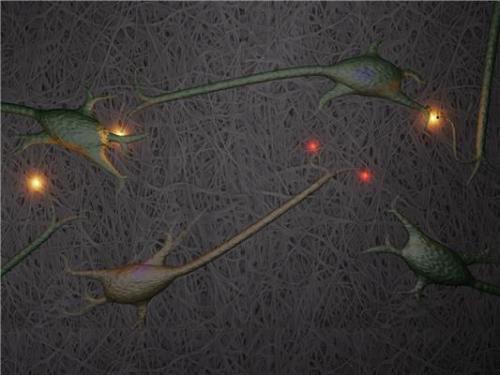A team of scientists from the University of Gothenburg and Chalmers has demonstrated that nanocellulose activates the creation of neural networks, paving the way to construct a 3D brain model to take brain research to an entirely new level.
 Nerve cells growing on a three-dimensional nanocellulose scaffold. One of the applications the research group would like to study is destruction of synapses between nerve cells, which is one of the earliest signs of Alzheimer’s disease. Synapses are the connections between nerve cells. In the image, the functioning synapses are yellow and the red spots show where synapses have been destroyed. (Illustration: Philip Krantz, Chalmers.)
Nerve cells growing on a three-dimensional nanocellulose scaffold. One of the applications the research group would like to study is destruction of synapses between nerve cells, which is one of the earliest signs of Alzheimer’s disease. Synapses are the connections between nerve cells. In the image, the functioning synapses are yellow and the red spots show where synapses have been destroyed. (Illustration: Philip Krantz, Chalmers.)
The research work on growing human nerve cells on nanocellulose has been carried out for more than a period of two years. Professor Paul Gatenholm, one of the researchers from Chalmers, explained that until recently the researchers were not able to prevent the cells from dying after some time, because they failed to attach the cells to the scaffold. However, after a string of experiments, they developed a stable method to make the scaffold more positively charged, enabling the cells to get attached to the scaffold.
After their attachment with the scaffold, the nerve cells started growing and creating contacts or synapses with each other, resulting in the formation of a neural network comprising hundreds of cells. The scientists can now produce nerve impulses by using chemical signal substances and electrical impulses. They can also probe the reaction between nerve cells and other molecules, such as drugs. They are working on developing artificial brains, opening the door for new opportunities in healthcare and brain research, and in due course may lead towards biocomputer development.
At first, the scientists wanted to use the method to probe synapses damage between nerve cells, which is one of the earliest symptoms of Alzheimer’s disease. For instance, they wanted to study the reaction between the nerve cells and the spinal fluid of patients and then to evaluate several pharmaceutical candidates that are capable of slowing down the damage of synapses. Moreover, this method can be used as an ideal replacement to animals used in brain research.
Gatenholm stated that nerve cells can be made to grow in a 3D matrix by producing pores in nanocellulose, creating an actual cultivation environment, which is more analogous to a real brain than a 3D cell cultivation well. Presently, he is involved in several projects based on nanocellulose. In one of these projects, the scientists are trying to create cartilage to make synthetic outer ears using nanocellulose. Pre-clinical studies are being conducted on artificial blood vessels using nanocellulose.